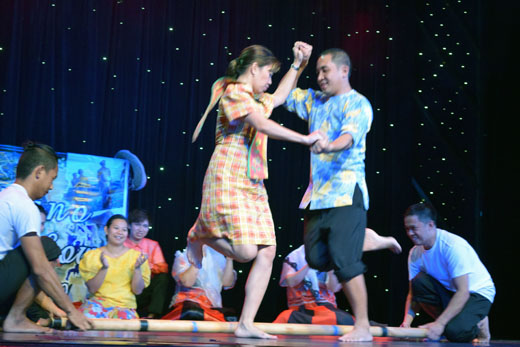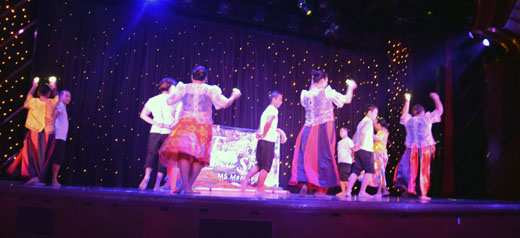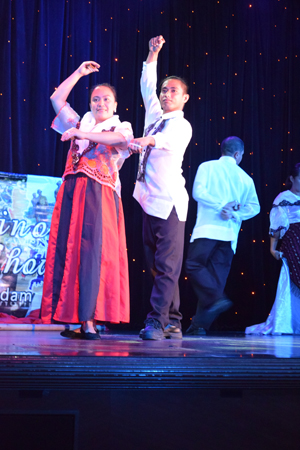Editor’s Note: This is the 32nd in a series of stories researched during Don and Nancy Harrison’s 50th Wedding Anniversary cruise from Sydney, Australia, to San Diego. Previous installments of the series, which runs every Thursday, may be found by tapping the number of the installment: 1, 2,3,4, 5, 6, 7,8, 9, 10, 11, 12,13, 14,15, 16, 17, 18,19,20, 21, 22, 23, 24, 25, 26, 27, 28, 29, 30, 31
By Donald H. Harrison

AT SEA, Aboard MS Maasdam — The second largest contingent of crewmembers aboard the Maasdam hail from the Philippines, and like the Indonesians earlier in our cruise, some of them wanted to share with the passengers a part of their culture. Accordingly, they staged a Filipino crew show, which introduced us to some of the songs of their country and, memorably, to three of the dances.
The Tinikling is perhaps the best-known dance of the Philippines. It is named for a bird that gingerly dances through the rice paddies, winning the farmers’ admiration for their agility and condemnation for their thievery. To assist the dance, two helpers kneel on the floor, grasping the ends of two long bamboo poles. Twice they bang the poles against the floor, but on the third time they snap the poles together. The barefoot dancers hop in between the poles on the first two beats, but make sure to hop outside of them on the dangerous third beat. As the dance progresses, the beat gets faster — and yes, it’s more dangerous.
Cynthia Lebrun Yaffe, a Filipina married to my cousin Marc Yaffe, remembered watching fellow students at her school dancing the Tinikling. “Nobody broke their ankles,” she laughed, although it seemed such a fate always was in prospect. “The secret is to get in the beat zone and forget about your nerves.”

On our ship, a young man and woman engaged in the dance, sometimes holding hands as bird-like they gracefully hopped over the bamboo poles. They won the enthusiastic applause of the passengers, who packed the two-story Showroom of the Sea for the occasion.
There are 7,641 islands in the Philippines. The Tinikling dance comes from the island of Leyte, best known to Americans as the island to which U.S. General Douglas MacArthur waded ashore in 1944, proclaiming “I have returned,” fulfilling a pledge he made two years before when he had to evacuate the Philippines in the face of the Japanese invasion. MacArthur’s landing presaged the Battle of Leyte Gulf, the largest naval battle of World War II and a double disaster for the Japanese military. Numerous Japanese ships and planes were destroyed in the four-day engagement, and the oil of the Philippines, needed for military purposes, was denied to Japan.

The candlelight dance, Pandango sa Ilaw, was another offering. The story was told that on the beach, wives and family of fishermen would perform this dance while holding lanterns to help guide fishing boats back home at night. The candlelight dance originated on the island of Luzon, which is the largest and most populous island of the Philippines. Manila, the Philippine capital, is situated on Luzon.
Cousin Cynthia, who grew up in Manila, said she never danced the candlelight dance either back in her school girl days, although she saw it performed. It is tricky because dancers hold a votive in each hand, and in some cases on their head. “Although the standard ‘waltzy’ steps are not difficult, when the dancers have to roll around on the ground not breaking beat nor dropping the head votive, that’s a different story,” Cynthia said.

However, she did recall performing with her classmates the third dance of the Filipino Crew show, La Jota Moncadeña, a dance influenced by the three and a half centuries that Spain ruled the Philippines as a colony. It is sometimes called the “castanets dance,” because each dancer clicks together two unstrung pieces of bamboo in accompaniment of the slow, stately movements.
Typically, La Jota Moncadeña was staged in honor of visiting dignitaries. Moncada, the town where the dance originated, is in the Tarlac province of central Luzon. The province is remembered in history as one of the first to join the uprising in the late 19th century against Spanish rule. Remembering her childhood experience dancing La Jota Moncadeña, Cynthia recalled proudly, “I never broke a finger, and I didn’t fall. But the day I was to perform the dance, I forgot my sticks at home!”
Neither did the crewmembers of the Maasdam, who also treated us to the singing of the Philippines’ National Anthem (for which we all stood) and to Ang Bayan Ko, a ballad which translated from Tagalog evokes the history of a country that first was conquered by the Spaniards, and later, became a commonwealth of the United States, before it eventually won its independence. Given that the Philippines are independent today, it would seem that the song is outdated. But Ang Bayan Ko became a protest song during the dictatorial administration of President Ferdinand Marcos and his free-spending First Lady Imelda Marcos. Even today, under the administration of President Rodrigo Duterte, there is concern in the Philippines about the return of absolutism.
Here are the lyrics translated into English:
My country The Philippines
Land of gold and flowers
Love bestowed to her
Offered beauty and glow
 Due to her beauty and grace
Due to her beauty and grace
Foreigners are tempted
My country, they enslaved you
Gave you endless suffering
Even bird that fly freely
Will cry once caged
My land so fair
Yearns to break free
Philippines that I so adore
Nest of tears and poverty
All that I desire
To see you rise and free
*
Harrison is editor of San Diego Jewish World. He may be contacted via donald.harrison@sdjewishworld.com
Pingback: Of Hawaiian judges, royalty, Jews, and Torah | San Diego Jewish World
Pingback: A medical evacuation from the Maasdam | San Diego Jewish World